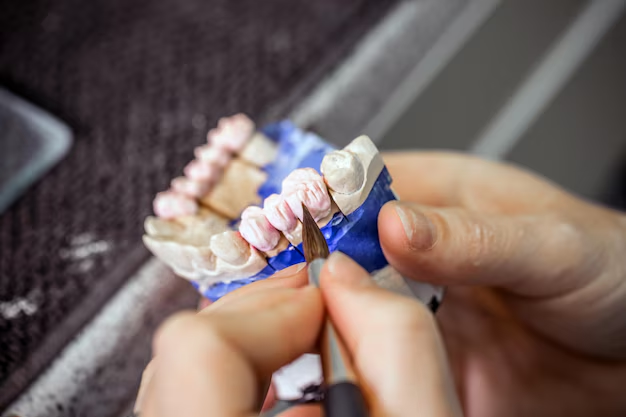Understanding Dental Bridges: What You Need to Know
If you've ever faced the loss of a tooth, the world of dental restorations might seem vast and overwhelming. Among the various options, dental bridges represent a cornerstone technique in restorative dentistry, designed to fill the gaps left by missing teeth. Grasping the essentials of dental bridges can empower you to make informed decisions about your oral health, especially within the broader context of dentures and other teeth replacement options.
🦷 What Are Dental Bridges?
A dental bridge is a fixed dental restoration used to replace one or more missing teeth by literally "bridging" the gap left in your mouth. They are typically anchored to the natural teeth or dental implants adjacent to the missing tooth space, known as abutment teeth. Between these abutments is the pontic, or false tooth, which serves to fill the gap.
Types of Dental Bridges
- Traditional Bridges: These are the most commonly used type. They involve creating a crown for the tooth or implant on either side of the missing tooth, with a pontic placed in between.
- Cantilever Bridges: Used when there is an adjacent tooth on only one side of the missing tooth. This bridge is generally not recommended for the back of the mouth where strong forces can damage it.
- Maryland Bonded Bridges: Also known as resin-bonded bridges, these use a metal or porcelain framework with "wings" on each side, bonded to the back of the existing teeth.
- Implant-Supported Bridges: As the name suggests, these are supported by dental implants rather than crowns or frameworks. They are considered very stable and may be used when more than one tooth is missing.
Why Opt for Dental Bridges?
Replacing missing teeth is more than a cosmetic decision. Here are some compelling reasons to consider them:
- Enhanced Functionality: Missing teeth can impair your ability to chew and speak properly.
- Prevent Teeth Shifting: A gap due to missing teeth can cause your remaining teeth to shift, leading to bite problems and other complications.
- Cosmetic Appeal: Bridges help restore the natural look of your smile and improve your facial aesthetics.
- Oral Health: Filling gaps can help maintain the structure of your mouth and prevent bone loss.
The Procedure: What to Expect
Initial Consultation
To determine whether a bridge is suitable, a dentist will evaluate your oral health, including the abutment teeth's strength and condition. X-rays and digital scans are often part of this assessment.
Preparing the Abutment Teeth
For traditional bridges, the dentist will prepare the abutment teeth by removing a portion of enamel, ensuring there's space for a crown. An impression of your teeth is then made to create a model that the bridge, pontic, and crowns will be based on.
Temporary Bridge
While the permanent bridge is being fabricated, a temporary one will be placed to protect the exposed teeth and gums.
Fitting the Permanent Bridge
Once the permanent bridge is ready, your dentist will remove the temporary one and place the new bridge, checking its fit and making necessary adjustments to ensure comfort and functionality.
Caring for Your Dental Bridge
Daily Hygiene
Maintaining impeccable oral hygiene is crucial:
- Brushing: Use a soft-bristled brush at least twice a day.
- Flossing: Special flossing tools are available to clean beneath the bridge effectively.
Regular Dental Check-Ups
Regular check-ups help ensure your bridge remains in good condition and that no underlying issues develop.
Lifestyle Considerations
Avoid habits like chewing ice or other hard objects and consuming excessive amounts of sugary foods, which can damage your bridge.
Alternatives to Dental Bridges
While bridges are effective, exploring other tooth replacement options can be valuable:
- Dentures: Removable appliances that can replace multiple missing teeth.
- Implants: A more permanent solution, implants are titanium posts surgically placed into the jawbone to serve as tooth roots.
- Partial Dentures: For those who require only partial replacement along with some bridge-like functionality.
Comparing Costs and Longevity
Financial Considerations
The cost of dental bridges can vary based on materials, type, and specific dental practices. While initially more expensive, implant-supported bridges could offer greater longevity compared with traditional options.
Lifespan of Dental Bridges
With proper care, bridges can last anywhere from 5 to 15 years or more, depending on the type and your oral hygiene habits.
Summary: Key Details About Dental Bridges
Here's a compact breakdown of essential highlights:
- Bridges are fixed restorations that replace missing teeth by bridging gaps.
- They can be traditional, cantilever, Maryland-bonded, or implant-supported.
- Beyond aesthetics, they help improve functionality, prevent teeth shifting, and protect oral health.
- Good hygiene: Essential for longevity, including careful brushing and flossing.
- Alternatives like dentures and implants are available for those exploring other replacements.
- Bridges are a significant investment; however, with excellent care, they can serve well for many years.
💡 Tip: Always discuss with your dentist about the best replacement option tailored to your specific dental health, lifestyle needs, and budget. Regular check-ups ensure continued dental health and bridge stability.

Related Topics
- a Bridge For Teeth
- a Denture Plan That You Can Pay Monthly Payments
- Are Dentures Covered By Insurance
- Are Dentures Covered By Medicare
- Are Dentures Uncomfortable
- Are Permanent Dentures Thinner Than Temporary Dentures
- Are Snap-in Dentures Covered By Insurance
- Are There Plastic Dental Partials With Metal
- Can a Tooth Be Added To a Valplast Denture
- Can Dogs Get Dentures